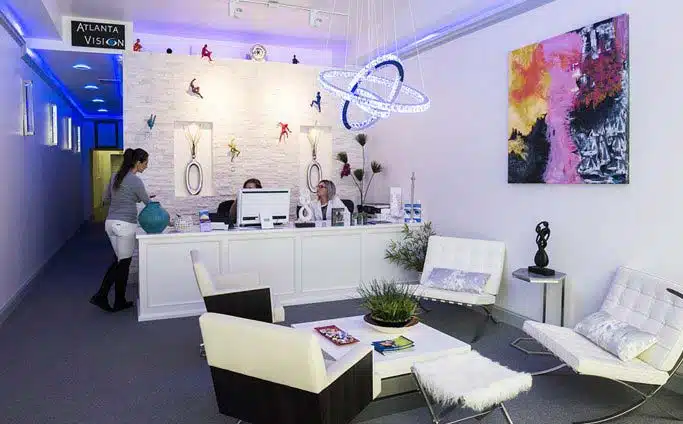If you’re seeking permanent freedom from glasses or contact lenses, modern vision correction procedures offer life-changing possibilities. Among these advanced surgical options, SMILE and LASIK stand out as leading choices.
While both procedures effectively correct refractive errors, they differ significantly in technique, recovery, and suitability for specific patients. Keep reading to learn more about whether SMILE is safer than LASIK and which procedure could be right for you.
What Is SMILE and How Does It Work?
SMILE is a state-of-the-art laser vision correction procedure that corrects nearsightedness and astigmatism. During the procedure, your ophthalmologist uses a femtosecond laser to create a small, precisely shaped disk of tissue in your cornea called a lenticule.

This lenticule is then removed through a tiny incision, which permanently reshapes the cornea, allowing light to focus properly on the retina and correcting refractive errors. This modern approach to vision correction achieves similar results to LASIK with minimal effects on the surrounding corneal nerves and tissues.
Key Differences Between SMILE and LASIK
Understanding the fundamental differences between LASIK and SMILE can help you and your eye doctor choose the best vision correction procedure for you.
Surgical Technique: Incision vs. Flap
The most significant distinction between SMILE and LASIK lies in their approach to accessing the cornea. LASIK requires making a small flap in the cornea, then folding it back to reshape the tissue underneath.
Once complete, your LASIK surgeon returns the flap to its original position, acting as a natural bandage while you heal. SMILE uses a small incision rather than creating a flap, resulting in:
- Less disruption to the corneal nerve fibers
- Reduced risk of flap-related complications
- Minimal impact on the outer corneal surface
Recovery Experience and Timeline
While individual healing varies, with SMILE, most patients experience:
- Faster stabilization of vision
- Shorter recovery time
- Less postoperative discomfort
- Quicker return to normal activities
This is because the incision made during SMILE is smaller than the flap made during LASIK, allowing for faster healing.
Side Effects
Both procedures have excellent safety records, but SMILE has been shown to have:
- Lower incidence of severe dry eye
- Reduced risk of flap complications (as no flap is created)
- Less corneal nerve disruption
- Minimal risk of corneal ectasia
Treatment of Refractive Errors
While LASIK can correct nearsightedness, farsightedness, and astigmatism, SMILE can only correct nearsightedness and astigmatism. If you are farsighted and not a good candidate for LASIK, you may be a good candidate for another LASIK alternative called PRK.
Is SMILE Safer Than LASIK?
SMILE and LASIK have established impressive safety records and high patient satisfaction rates. However, SMILE may offer more safety advantages than LASIK for specific patients, including:
Athletes Who Play Contact Sports
SMILE may be safer than LASIK for patients who regularly participate in contact sports or high-impact activities. This is because the flap created during LASIK has the potential to become dislodged during a high-impact sports injury, leading to potential complications like vision impairment.

SMILE does not require making a flap to reshape the cornea, eliminating the risk of flap complications in athletes.
Patients with Dry Eye Concerns
Patients with pre-existing dry eye conditions or those concerned about this common side effect of LASIK may benefit from SMILE. The SMILE procedure has a lower incidence of severe postoperative dry eye because it interferes with fewer corneal nerves that regulate tear production.
Patients with Thinner Corneas
If your corneas are not thick enough, you may not be able to safely accommodate the flap needed for the LASIK procedure. Since there is no flap made during SMILE, it provides an excellent alternative for patients with thinner corneas.
Who Can Safely Undergo SMILE?
Not everyone qualifies for SMILE, and proper patient selection is crucial for safe, optimal outcomes. Ideal candidates include patients who:
- Are 22 years or older
- Have had stable vision for at least one year
- Have nearsightedness and/or astigmatism
- Are not pregnant or nursing
- Do not have eye conditions like cataracts, glaucoma, or active eye infections
- Do not have uncontrolled diabetes or autoimmune conditions like lupus, Sjogren’s syndrome, or rheumatoid arthritis
- Have realistic expectations about the procedure
Your eye doctor at Atlanta Vision Institute will have you attend a consultation and undergo an eye exam to assess whether you are a good candidate for SMILE. This appointment will involve reviewing these factors as well as your medical history, refractive errors, and visual goals.
The Benefits of Choosing SMILE
For qualified candidates, SMILE offers several compelling advantages:
Freedom From Visual Aids
After SMILE, most patients enjoy complete freedom from glasses and contacts. This means no more digging through your bag for your glasses or wondering whether you ordered enough contacts to get you through the next month.

Instead, you’ll wake up with crisp, clear vision every day and can do all your favorite activities without the hassles of visual aids.
Minimal Invasiveness
The small incision approach of SMILE minimizes impacts on the eye, resulting in short recovery times, lower risk of complications than other refractive procedures, and a quicker return to normal activities.
Advanced Precision Technology
SMILE utilizes state-of-the-art femtosecond laser technology that creates precise, predictable results, minimizes tissue disruption, and delivers consistent outcomes.
Long-Term Vision Correction
SMILE permanently reshapes the cornea to correct refractive errors. This means that your results will be permanent, with most patients enjoying crystal-clear vision for decades.
However, vision changes from unrelated conditions like glaucoma, cataracts, and age-related macular degeneration are still possible, as they affect different parts of the eye.
Get All Your Questions Answered by an Expert Ophthalmologist
If you’re considering vision correction surgery, you should attend a consultation with one of our experienced ophthalmologists to discover whether SMILE, LASIK, or another vision correction option is best suited to your vision needs and goals. Get started on your journey to clearer vision when you schedule an appointment at Atlanta Vision Institute in Atlanta, GA, today!

Please Take Our LASIK or Cataract Surgery Quiz
Take our vision quiz to find out if you qualify for LASIK or cataract surgery!


